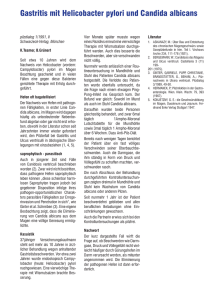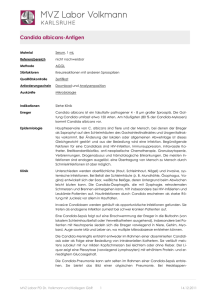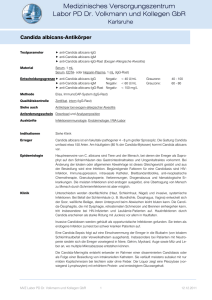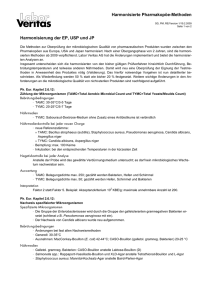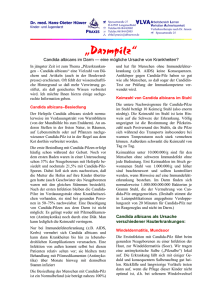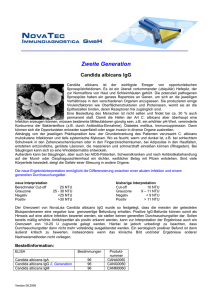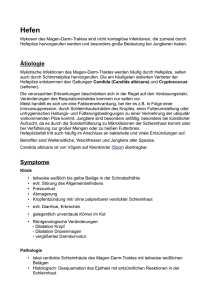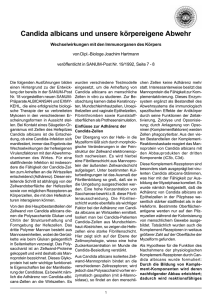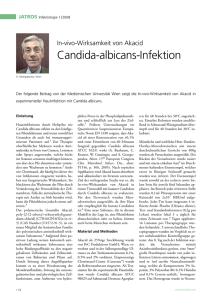Molekulare Mechanismen der Candida-Sepsis
Werbung
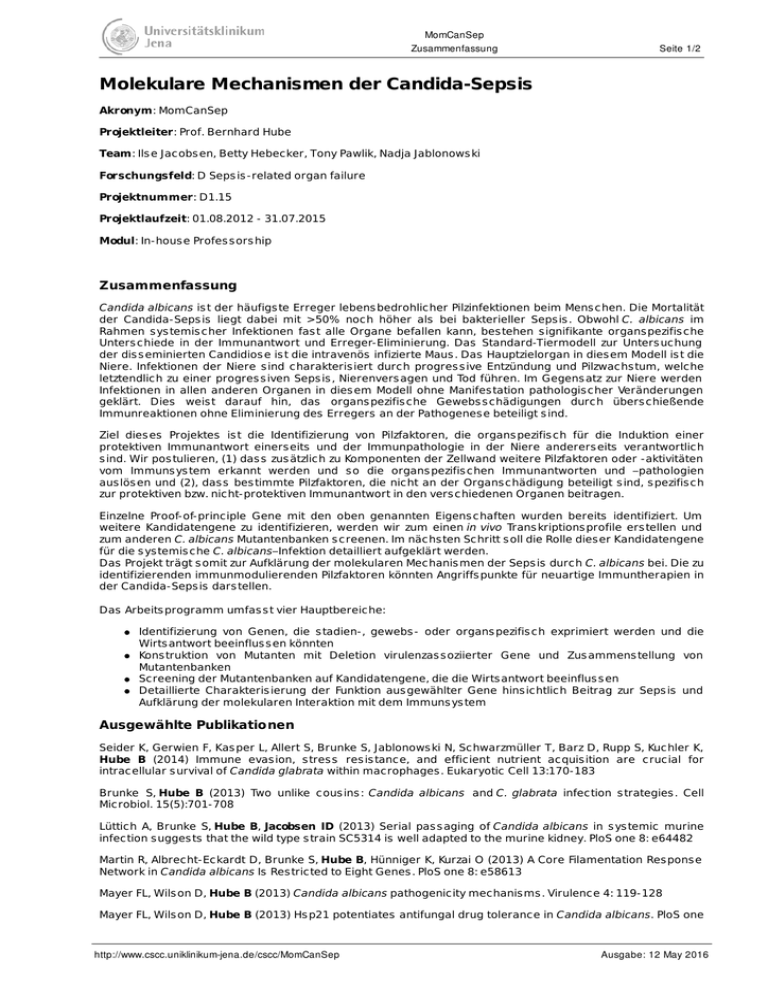
MomCanSep Zusammenfassung Seite 1/2 Molekulare Mechanismen der Candida-Sepsis Akronym: MomCanSep Projektleiter: Prof. Bernhard Hube Team: Ils e Jacobs en, Betty Hebecker, Tony Pawlik, Nadja Jablonows ki Forschungsfeld: D Seps is -related organ failure Projektnummer: D1.15 Projektlaufzeit: 01.08.2012 - 31.07.2015 Modul: In-hous e Profes s ors hip Zusammenfassung Candida albicans is t der häufigs te Erreger lebens bedrohlicher Pilzinfektionen beim Mens chen. Die Mortalität der Candida-Seps is liegt dabei mit >50% noch höher als bei bakterieller Seps is . Obwohl C. albicans im Rahmen s ys temis cher Infektionen fas t alle Organe befallen kann, bes tehen s ignifikante organs pezifis che Unters chiede in der Immunantwort und Erreger-Eliminierung. Das Standard-Tiermodell zur Unters uchung der dis s eminierten Candidios e is t die intravenös infizierte Maus . Das Hauptzielorgan in dies em Modell is t die Niere. Infektionen der Niere s ind charakteris iert durch progres s ive Entzündung und Pilzwachs tum, welche letztendlich zu einer progres s iven Seps is , Nierenvers agen und Tod führen. Im Gegens atz zur Niere werden Infektionen in allen anderen Organen in dies em Modell ohne Manifes tation pathologis cher Veränderungen geklärt. Dies weis t darauf hin, das organs pezifis che Gewebs s chädigungen durch übers chießende Immunreaktionen ohne Eliminierung des Erregers an der Pathogenes e beteiligt s ind. Ziel dies es Projektes is t die Identifizierung von Pilzfaktoren, die organs pezifis ch für die Induktion einer protektiven Immunantwort einers eits und der Immunpathologie in der Niere anderers eits verantwortlich s ind. Wir pos tulieren, (1) das s zus ätzlich zu Komponenten der Zellwand weitere Pilzfaktoren oder -aktivitäten vom Immuns ys tem erkannt werden und s o die organs pezifis chen Immunantworten und –pathologien aus lös en und (2), das s bes timmte Pilzfaktoren, die nicht an der Organs chädigung beteiligt s ind, s pezifis ch zur protektiven bzw. nicht-protektiven Immunantwort in den vers chiedenen Organen beitragen. Einzelne Proof-of-principle Gene mit den oben genannten Eigens chaften wurden bereits identifiziert. Um weitere Kandidatengene zu identifizieren, werden wir zum einen in vivo Trans kriptions profile ers tellen und zum anderen C. albicans Mutantenbanken s creenen. Im nächs ten Schritt s oll die Rolle dies er Kandidatengene für die s ys temis che C. albicans–Infektion detailliert aufgeklärt werden. Das Projekt trägt s omit zur Aufklärung der molekularen Mechanis men der Seps is durch C. albicans bei. Die zu identifizierenden immunmodulierenden Pilzfaktoren könnten Angriffs punkte für neuartige Immuntherapien in der Candida-Seps is dars tellen. Das Arbeits programm umfas s t vier Hauptbereiche: Identifizierung von Genen, die s tadien-, gewebs - oder organs pezifis ch exprimiert werden und die Wirts antwort beeinflus s en könnten Kons truktion von Mutanten mit Deletion virulenzas s oziierter Gene und Zus ammens tellung von Mutantenbanken Screening der Mutantenbanken auf Kandidatengene, die die Wirts antwort beeinflus s en Detaillierte Charakteris ierung der Funktion aus gewählter Gene hins ichtlich Beitrag zur Seps is und Aufklärung der molekularen Interaktion mit dem Immuns ys tem Ausgewählte Publikationen Seider K, Gerwien F, Kas per L, Allert S, Brunke S, Jablonows ki N, Schwarzmüller T, Barz D, Rupp S, Kuchler K, Hube B (2014) Immune evas ion, s tres s res is tance, and efficient nutrient acquis ition are crucial for intracellular s urvival of Candida glabrata within macrophages . Eukaryotic Cell 13:170-183 Brunke S, Hube B (2013) Two unlike cous ins : Candida albicans and C. glabrata infection s trategies . Cell Microbiol. 15(5):701-708 Lüttich A, Brunke S, Hube B, Jacobsen ID (2013) Serial pas s aging of Candida albicans in s ys temic murine infection s ugges ts that the wild type s train SC5314 is well adapted to the murine kidney. PloS one 8: e64482 Martin R, Albrecht-Eckardt D, Brunke S, Hube B, Hünniger K, Kurzai O (2013) A Core Filamentation Res pons e Network in Candida albicans Is Res tricted to Eight Genes . PloS one 8: e58613 Mayer FL, Wils on D, Hube B (2013) Candida albicans pathogenicity mechanis ms . Virulence 4: 119-128 Mayer FL, Wils on D, Hube B (2013) Hs p21 potentiates antifungal drug tolerance in Candida albicans. PloS one http://www.cscc.uniklinikum-jena.de/cscc/MomCanSep Ausgabe: 12 May 2016 MomCanSep Kontakt Seite 2/2 8: e60417 Miramon P, Kas per L, Hube B (2013) Thriving within the hos t: Candida s pp. interactions with phagocytic cells . Med Microbiol Immunol 202: 183-195 Pietrella D, Pandey N, Gabrielli E, Pericolini E, Perito S, Kas per L, Bis toni F, Cas s one A, Hube B, Vecchiarelli A. (2013) Secreted as partic proteas es of Candida albicans activate the NLRP3 inflammas ome. Eur J Immunol. 43: 679-692 Citiulo F, Jacobsen ID, Miramon P, Schild L, Brunke S, Zipfel P, Brock M, Hube B, Wils on D (2012) Candida albicans s cavenges hos t zinc via Pra1 during endothelial invas ion. PLoS Pathog 8: e1002777 (® Publikations preis der DMyk) Gow NA, Hube B (2012) Importance of the Candida albicans cell wall during commens alis m and infection. Current Opinion in Microbiology 15: 406-412 Jacobsen ID, Wils on D, Wächtler B, Brunke S, Naglik JR, Hube B (2012) Candida albicans dimorphis m as a therapeutic target. Expert Rev Anti Infect Ther. 10(1):85-93 Lüttich A, Brunke S, Hube B. (2012) Is olation and amplification of fungal RNA for microarray analys is from hos t s amples . Methods Mol Biol. 845:411-21 Mayer FL, Wils on D, Jacobs en ID, Miramon P, Sles iona S, Bohovych IM, Brown AJ, Hube B (2012) Small but crucial: the novel s mall heat s hock protein Hs p21 mediates s tres s adaptation and virulence in Candida albicans. PloS one 7: e38584 Miramón P, Dunker C, Windecker H, Bohovych IM, Brown AJ, Kurzai O, Hube B. (2012) Cellular Res pons es of Candida albicans to Phagocytos is and the Extracellular Activities of Neutrophils Are Critical to Counteract Carbohydrate Starvation, Oxidative and Nitros ative Stres s . PLoS One. 7(12):e52850 Kontakt Prof. Bernhard Hube Tel. + 49 (0)3641 - 532 1401 oder 00 Abteilung Mikrobielle Pathogenitäts mechanis men Leibniz Ins titut für Naturs toff-Fors chung und Infektions biologie e.V. Hans -Knöll-Ins titut (HKI) Beutenbergs traße 11a 07745 Jena Webs eite der Abteilung Mikrobielle Pathogenitäts mechanis men (MPM) des HKI http://www.cscc.uniklinikum-jena.de/cscc/MomCanSep Ausgabe: 12 May 2016
